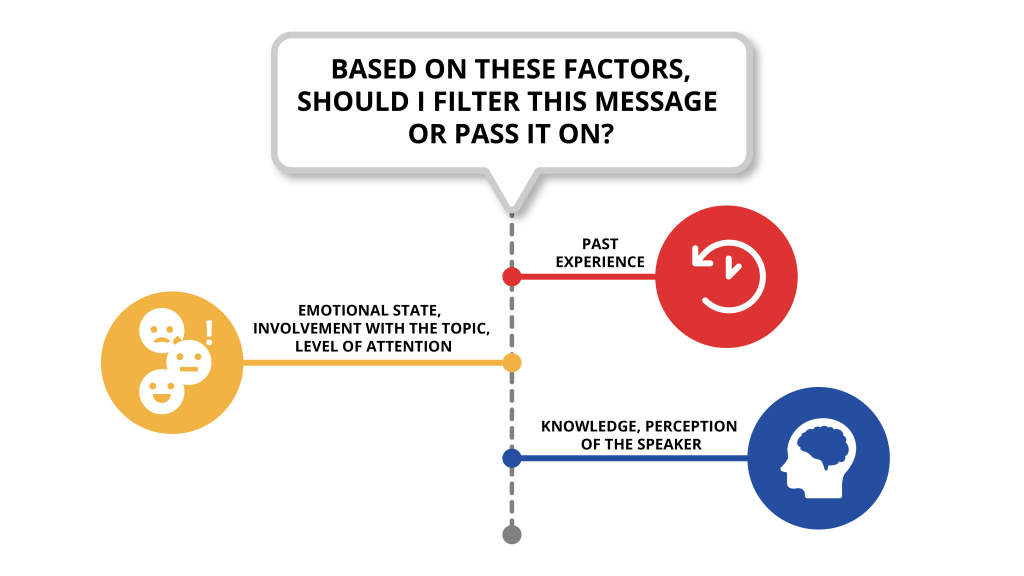5.3 Communication Barriers
Learning Objectives
- Distinguish different ways that the communication process can be sidetracked.
- Consider the problem of poor listening and how to promote active listening.
Barriers to Effective Communication
Communicating can be more of a challenge than you think, when you realize the many things that can stand in the way of effective communication. These include filtering, selective perception, information overload, emotional disconnects, lack of source familiarity or credibility, workplace gossip, semantics, gender differences, differences in meaning between Sender and Receiver, and biased language. Let’s briefly examine each of these barriers.
Filtering
Filtering is the distortion or withholding of information to manage a person’s reactions. Some examples of filtering include a manager who keeps her division’s poor sales figures from her boss, the vice president, fearing that the bad news will make him angry. The old saying, “Don’t shoot the messenger!” illustrates the tendency of Receivers (in this case, the vice president) to vent their negative response to unwanted Messages on the Sender. A gatekeeper (the vice president’s assistant, perhaps) who doesn’t pass along a complete Message is also filtering. The vice president may delete the e-mail announcing the quarter’s sales figures before reading it, blocking the Message before it arrives.
As you can see, filtering prevents members of an organization from getting a complete picture of the way things are. To maximize your chances of sending and receiving effective communications, it’s helpful to deliver a Message in multiple ways and to seek information from multiple sources. In this way, the effect of any one person’s filtering the Message will be diminished.
Since people tend to filter bad news more during upward communication, it is also helpful to remember that those below you in an organization may be wary of sharing bad news. One way to defuse the tendency to filter is to reward employees who clearly convey information upward, regardless of whether the news is good and bad.

Here are some of the criteria that individuals may use when deciding whether to filter a Message or pass it on:
- Past experience: Was the Sender rewarded for passing along news of this kind in the past, or was she criticized?
- Knowledge, perception of the speaker: Has the Receiver’s direct superior made it clear that “no news is good news?”
- Emotional state, involvement with the topic, level of attention: Does the Sender’s fear of failure or criticism prevent him from conveying the Message? Is the topic within his realm of expertise, increasing his confidence in his ability to decode it, or is he out of his comfort zone when it comes to evaluating the Message’s significance? Are personal concerns impacting his ability to judge the Message’s value?
Once again, filtering can lead to miscommunications in business. Each listener translates the Message into his or her own words, creating his or her own version of what was said (Alessandra & Hunsaker, 1993).
Selective Perception
Selective perception refers to filtering what we see and hear to suit our own needs. Often, much of this process is unconscious. “We simply are bombarded with too much stimuli every day to pay equal attention to everything so we pick and choose according to our own needs (Pope, 2008).” Selective perception is a time-saver, a necessary tool in a complex culture. But it can also lead to making assumptions and mistakes.
Think back to the earlier example conversation between Bill and his boss about toner cartridges. Since Bill found his boss’s to-do list to be unreasonably demanding, he assumed the request could wait. (How else could he do everything else on the list?) The boss, assuming that Bill had heard the urgency in her request, assumed that Bill would place the order before returning to the other tasks on the list.
Both members of this organization were using selective perception to evaluate the communication. Bill’s perception was that the task of ordering could wait. The boss’s perception was that her time frame was clear, though unstated. When two selective perceptions collide, a misunderstanding occurs.
Information Overload
Information overload can be defined as “occurring when the information processing demands on an individual’s time to perform interactions and internal calculations exceed the supply or capacity of time available for such processing (Schick et. al., 1990).” Messages reach us in countless ways every day. Some are societal—advertisements that we may hear or see in the course of our day. Others are professional—e-mails, and memos, voice mails, and conversations from our colleagues. Others are personal—messages and conversations from our loved ones and friends.
Add these together and it’s easy to see how we may be receiving more information than we can take in. This state of imbalance is known as information overload. Experts note that information overload is “A symptom of the high-tech age, which is too much information for one human being to absorb in an expanding world of people and technology. It comes from all sources including TV, newspapers, and magazines as well as wanted and unwanted regular mail, e-mail and faxes. It has been exacerbated enormously because of the formidable number of results obtained from Web search engines (PC Magazine, 2008).” Other research shows that working in such fragmented fashion has a significant negative effect on efficiency, creativity, and mental acuity (Overholt, 2001).
Going back to our example of Bill. Let’s say he’s in his cubicle on the phone with a supplier. While he’s talking, he hears the chime of e-mail alerting him to an important message from his boss. He’s scanning through it quickly, while still on the phone, when a coworker pokes his head around the cubicle corner to remind Bill that he’s late for a staff meeting. The supplier on the other end of the phone line has just given Bill a choice among the products and delivery dates he requested. Bill realizes he missed hearing the first two options, but he doesn’t have time to ask the supplier to repeat them all or to try reconnecting to place the order at a later time. He chooses the third option—at least he heard that one, he reasons, and it seemed fair. How good was Bill’s decision amid all the information he was processing at the same time?
Dealing with Information Overload
One of the challenges in many organizations is dealing with a deluge of emails that can lead to information overload. Crucial messages may be drowned out by the volume in your inbox. Add the practice of “reply to all” that means that you may get five or six versions of an initial e-mail and need to understand all of the responses as well as the initial communication before responding or deciding that the issue is resolved and no response is needed. Here are suggestions to dealing with e-mail overload.
One way to reduce the volume and the time you spend on e-mail is to unsubscribe to e-newsletters or turn off notifications from social media accounts. Also consider whether your colleagues or direct reports are copying you on too many emails as an FYI. If yes, explain that you only need to be updated under specific circumstances or when final decisions are made.
You will also want to set up a system that will organize your inbox into “folders” that will allow you to manage the flow of messages into groups that will allow you to address them appropriately. Your system might look something like this:
- Inbox: Treat this as a holding pen. E-mails shouldn’t stay here any longer than it takes for you to file them into another folder. The exception is when you respond immediately and are waiting for an immediate response.
- Today: This is for items that need a response today.
- This week: This is for messages that require a response before the end of the week.
- This month/quarter: This is for everything that needs a longer-term response. Depending on your role, you may need a monthly or quarterly folder.
- FYI: This is for any items that are for information only and that you may want to refer back to in the future.
(Chingel, 2018)
Another thing to consider is your outgoing e-mail. If your outgoing messages are not specific, too long, unclear, or are copied too widely, your colleagues are likely to follow the same practice when communicating with you. Keep your communication clear and to the point, and managing your outbox will help make your inbound e-mails manageable.
Emotional disconnects
Emotional disconnects happen when the Sender or the Receiver is upset, whether about the subject at hand or about some unrelated incident that may have happened earlier. An effective communication requires a Sender and a Receiver who are open to speaking and listening to one another, despite possible differences in opinion or personality. One or both parties may have to put their emotions aside to achieve the goal of communicating clearly. A Receiver who is emotionally upset tends to ignore or distort what the Sender is saying. A Sender who is emotionally upset may be unable to present ideas or feelings effectively.
Lack of Source Credibility
Lack of source familiarity or credibility can derail communications, especially when humor is involved. Have you ever told a joke that fell flat? You and the Receiver lacked the common context that could have made it funny. (Or yes, it could have just been a lousy joke.) Sarcasm and irony are subtle, and potentially hurtful, commodities in business. It’s best to keep these types of communications out of the workplace as their benefits are limited, and their potential dangers are great. Lack of familiarity with the Sender can lead to misinterpreting humor, especially in less-rich information channels like e-mail.
Similarly, if the Sender lacks credibility or is untrustworthy, the Message will not get through. Receivers may be suspicious of the Sender’s motivations (“Why am I being told this?”). Likewise, if the Sender has communicated erroneous information in the past, or has created false emergencies, his current Message may be filtered.
Workplace gossip, also known as the grapevine, is a lifeline for many employees seeking information about their company (Kurland & Pelled, 2000). Researchers agree that the grapevine is an inevitable part of organizational life. Research finds that 70% of all organizational communication occurs at the grapevine level (Crampton, 1998). Employees trust their peers as a source of Messages, but the grapevine’s informal structure can be a barrier to effective communication from a leadership point of view. Its grassroots structure gives it greater credibility in the minds of employees than information delivered through official channels, even when that information is false. Some downsides of the office grapevine are that gossip offers politically minded insiders a powerful tool for disseminating communication (and self-promoting miscommunications). In addition, the grapevine lacks a specific Sender – who is at the root of the gossip network? When the news is volatile, suspicions may arise as to the person or persons behind the Message. Leaders who understand the grapevine’s power can use it to send and receive Messages of their own. They also decrease the grapevine’s power by sending official Messages quickly and accurately, should big news arise.
Semantics
Semantics is the study of meaning in communication. Words can mean different things to different people, or they might not mean anything to another person. Given the amount of Messages we send and receive every day, it makes sense that humans try to find shortcuts—a way to communicate things in code. In business, this code is known as jargon. Jargon is the language of specialized terms used by a group or profession. It is common shorthand among experts and if used sensibly can be a quick and efficient way of communicating. Every profession, trade, and organization has its own specialized terms (Wright, 2008). At first glance, jargon seems like a good thing—a quicker way to send an effective communication, the way text message abbreviations can send common messages in a shorter, yet understandable way. But that’s not always how things happen. Jargon can be an obstacle to effective communication, causing listeners to tune out or fostering ill-feeling between partners in a conversation. When jargon rules the day, the Message can get obscured.
A key question to ask before using jargon is, “Who is the Receiver of my Message?” If you are a specialist speaking to another specialist in your area, jargon may be the best way to send a message while forging a professional bond—similar to the way best friends can communicate in code. For example, an information technology (IT) systems analyst communicating with another IT employee may use jargon as a way of sharing information in a way that reinforces the pair’s shared knowledge. But that same conversation should be held in standard English, free of jargon, when communicating with staff members outside the IT group.
Here is a Web site of 80 buzz words in business. If you are not familiar with these, it may be helpful to learn some of them before you head into the workplace.
This article is a discussion as to why buzzwords and/or slang could be a problem:
Gender Differences
Gender differences in communication have been documented by a number of experts, however we know that we cannot put all members of any gender in a box, and we need to be extremely cautious about stereotyping. Additionally, a strictly binary approach (male and female) does not promote inclusivity and understanding of all members of our organizations. Please remember these points when working with others. Unfortunately, there is not enough research available on the communication styles of transgender, non-binary, and other gender identities.
Linguistics professor Deborah Tannen addressed gender differences in communication in her best-selling book You Just Don’t Understand: Women and Men in Conversation (Tannen, 1991). Men and women work together every day, but different styles of communication can sometimes work against them. Generally speaking, women like to ask questions before starting a project, while men tend to “jump right in.” A male leader who’s unaware of how women may communicate their readiness to work may misperceive a ready employee as not ready. Another difference is that men often speak in sports metaphors, while many women use their home as a starting place for analogies. Women who believe men are “only talking about the game” may be missing out on a chance to participate in a division’s strategy and opportunities for teamwork and “rallying the troops” for success (Krotz, 2008).
Being aware of these gender differences can be the first step in learning to work with others, as opposed to around them. For example, keep in mind that in this binary understanding, men tend to focus more on competition, data, and orders in their communications, while women tend to focus more on cooperation, intuition, and requests. Both styles can be effective in the right situations, but understanding the differences is a first step in avoiding misunderstandings based on them.
Differences in meaning often exist between the Sender and Receiver. “Mean what you say, and say what you mean.” It’s an easy thing to say. But in business, what do those words mean? Different words mean different things to different people. Age, education, and cultural background are all factors that influence how a person interprets words. The less we consider our audience, the greater our chances of miscommunication will be. When communication occurs in the cross-cultural context, extra caution is needed given that different words will be interpreted differently across cultures and different cultures have different norms regarding nonverbal communication. Eliminating jargon is one way of ensuring that our words will convey real-world concepts to others. Speaking to our audience, as opposed to about ourselves, is another. Nonverbal Messages can also have different meanings.
Table 5.3.1: Gestures Around the Globe (Axtell, 1998)
| 1. “V” for victory. Use this gesture with caution! While in North America it signs victory or peace, in England and Australia it means something closer to “take this!” | |
| 2. The “OK” gesture. While in North America it means things are going well, in France it means a person is thought to be worthless, in Japan it refers to money, and in Brazil, Russia, and Germany it means something really not appropriate for the workplace. | |
| 3. The “thumbs up” means one in Germany, five in Japan, but a good job in North America. This can lead to confusion. | |
| 4. “Hook ‘em horns.” This University of Texas rallying call looks like the horns of a bull. However, in Italy it means you are being tricked, while in Brazil and Venezuela it means you are warding off evil. | |
| 5. Waving your hand. In much of Europe waving your hand indicates a disagreement. However, in North America it is routinely used as a way to signal greetings or to get someone’s attention. |
Biased language can offend or stereotype others on the basis of their personal or group affiliation.
Effective communication is clear, factual, and goal-oriented. It is also respectful. Referring to a person by one adjective (a brain, a diabetic, an invalid) reduces that person to that one characteristic. Language that belittles or stereotypes a person poisons the communication process. Language that insults an individual or group based on age, ethnicity, sexual preference, or political beliefs violates public and private standards of decency, ranging from civil rights to corporate regulations.
The effort to create a neutral set of terms to refer to heritage and preferences has resulted in a debate over the nature of “political correctness.” Proponents of political correctness see it as a way to defuse the volatile nature of words that stereotyped groups and individuals in the past. Critics of political correctness see its vocabulary as stilted and needlessly cautious.
Many companies offer new employees written guides on standards of speech and conduct. These guides, augmented by common sense and courtesy, are solid starting points for effective, respectful workplace communication. Tips for appropriate workplace speech include but are not limited to:
- Instead of the traditional male pronoun when referring to people in general, alternating “he”, “she” and using “they” (even as a singular pronoun).
- Remembering that terms that feel respectful or comfortable to us may not be comfortable or respectful to others.
- Relying on human resources–generated guidelines.
Poor Listening and Active Listening
Former Chrysler CEO Lee Iacocca lamented, “I only wish I could find an institute that teaches people how to listen. After all, a good manager needs to listen at least as much as he needs to talk (Iacocca & Novak, 1984).” Research shows that listening skills are related to promotions (Sypher et. al., 1989). A Sender may strive to deliver a Message clearly, but the Receiver’s ability to listen effectively is equally vital to effective communication. The average worker spends 55% of her workdays listening, leaders listen up to 70% each day, but listening doesn’t lead to understanding in every case. Listening takes practice, skill, and concentration.
According to University of San Diego professor Phillip Hunsaker, “The consequences of poor listening are lower employee productivity, missed sales, unhappy customers, and billions of dollars of increased cost and lost profits. Poor listening is a factor in low employee morale and increased turnover because employees do not feel their managers listen to their needs, suggestions, or complaints (Alessandra & Hunsaker, 1993).” Clearly, if you hope to have a successful career in leadership, it behooves you to learn to be a good listener.
Alan Gulick, a Starbucks spokesperson, puts better listening to work in pursuit of better profits. If every Starbucks employee misheard one $10 order each day, he calculates, their errors would cost the company a billion dollars annually. To teach its employees to listen, Starbucks created a code that helps employees taking orders hear the size, flavor, and use of milk or decaf coffee. The person making the drink echoes the order aloud.
How can you improve your listening skills? The Roman philosopher Cicero said, “Silence is one of the great arts of conversation.” How often have we been in conversation with someone else where we are not really listening but itching to convey our portion? This behavior is known as “rehearsing.” It suggests the Receiver has no intention of considering the Sender’s Message and intends to respond to an earlier point instead. Clearly, rehearsing is an impediment to the communication process. Effective communication relies on another kind of listening: active listening.
Active listening can be defined as giving full attention to what other people are saying, taking time to understand the points being made, asking questions as appropriate, and not interrupting at inappropriate times (O*NET Resource Center, n.d). Active listening creates a real-time relationship between the Sender and the Receiver by acknowledging the content and receipt of a Message. As we’ve seen in the Starbucks example, repeating and confirming a Message’s content offers a way to confirm that the correct content is flowing between colleagues. The process creates a bond between coworkers while increasing the flow and accuracy of messaging.
The good news is that listening is a skill that can be learned (Brownell, 1990). The first step is to decide that we want to listen. Casting aside distractions, such as by reducing background or internal noise, is critical. The Receiver takes in the Sender’s Message silently, without speaking. Second, throughout the conversation, show the speaker that you’re listening. You can do this nonverbally by nodding your head and keeping your attention focused on the speaker. You can also do it verbally, by saying things like, “Yes,” “That’s interesting,” or other such verbal cues. As you’re listening, pay attention to the Sender’s body language for additional cues about how they’re feeling. Interestingly, silence plays a major role in active listening. During active listening, we are trying to understand what has been said, and in silence, we can consider the implications. We can’t consider information and reply to it at the same time. That’s where the power of silence comes into play. Finally, if anything is not clear to you, ask questions. Confirm that you’ve heard the message accurately, by repeating back a crucial piece like, “Great, I’ll see you at 2 p.m. in my office.” At the end of the conversation, a “thank you” from both parties is an optional but highly effective way of acknowledging each other’s teamwork. This TedTalk by Celeste Headlee throws some of these recommendations out the window – if we really are listening, we should not have to He that we are, as we will automatically be showing these behaviors.
Watch the video: 10 Ways to Have a Better Conversation with Celeste Headlee by Ted [11:21] (transcript available).
In summary, active listening creates a more dynamic relationship between Receiver and Sender. It strengthens personal investment in the information being shared. It also forges healthy working relationships among colleagues by making Speakers and Listeners equally valued members of the communication process.
Exercises
- Most people are poor listeners. Do you agree or disagree with this statement? Please support your position.
- Please share an example of how differences in shared meaning have affected you.
- Give an example of selective perception.
- Do you use jargon at or in your classes? If so, do you think it helps or hampers communication? Why or why not?
- In your experience, how is silence used in communication? How does your experience compare with the recommended use of silence in active listening?
- What are your thoughts on the TedTalk by Celeste Headlee? Do you feel her suggestions could increase your communication skills and strengthen your relationships?
Additional Resources
For further reading about gendered communication and non-verbal cues see Gendered Communication: Differences In Communication Styles.
“Communication Barriers” in Principles of Management by University of Minnesota is licensed under a Creative Commons Attribution-NonCommercial-ShareAlike 4.0 International License, except where otherwise noted.
“Types of Communication in Organizations” in Organizational Behaviour by OpenStax is licensed under a Creative Commons Attribution 4.0 International License.






